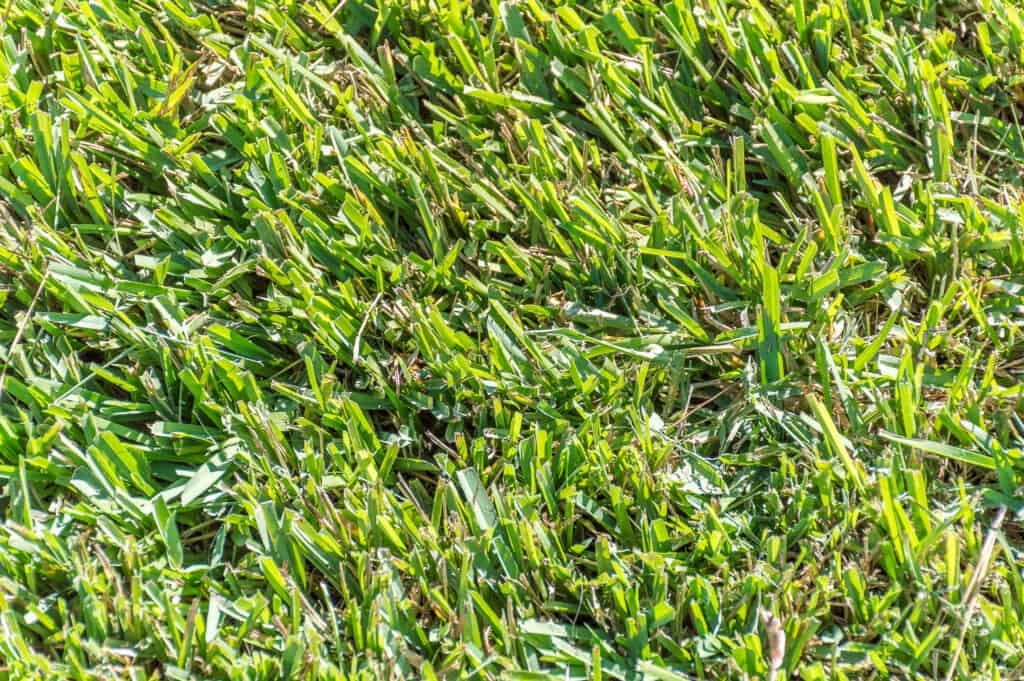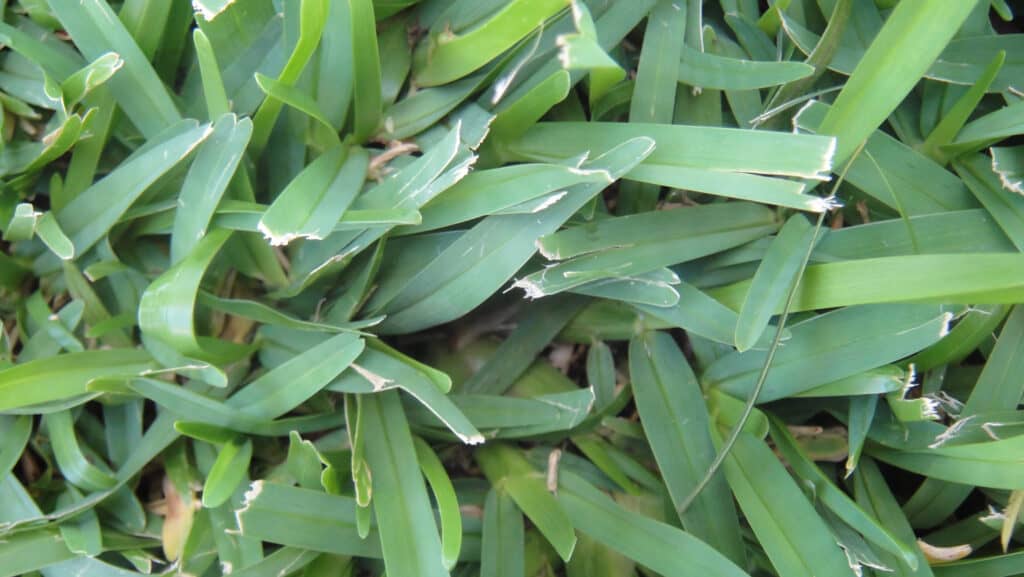Standard lawn grass species are cool-season grasses that flourish in the spring and fall’s cool, moist climate. Although less common and occasionally challenging to establish, warm-season grasses have the advantage of providing better turf quality during the hotter, drier summer months.
Centipede grass and zoysia grass are both warm-season grasses, but they differ greatly in terms of cold tolerance and regional adaptation. In this guide, we’ll explore some key differences between these two types of grass so you can make the right choice for your own lawn.
Comparing Centipede Grass and Zoysia Grass
The Key Differences Between Centipede Grass and Zoysia Grass
Low-growing perennial grasses like Zoysia and centipede grass eventually spread to create a homogenous, dense lawn. These warm-season species have limited tolerance for partial shade despite being well-adapted to heat. They make good low-maintenance lawn plant options. They do differ in some important ways, though.
Their climatic and regional adaptations may be the most notable distinction between centipede grass and zoysia grass. Centipede grass, which grows best in the southeast into Texas and is advised for U.S. Department of Agriculture Plant Hardiness Zones 8 – 10, favors places with abundant rainfall and moderate winters. Since it can thrive in USDA Zone 6, zoysia grass is substantially tougher and more suitable for dry climates like those in Arizona and California.
Wear tolerance is another significant distinction. Compared to centipede grass, zoysia grass is far more tolerant of intense foot activity.

Craig Russell/Shutterstock.com
Centipede Grass vs. Zoysia Grass: Classification
Centipede grass is classified as Eremochloa ophiuroides. This grass is part of the Poaceae family.
Zoysia grass is not a specific species, but rather a group of very similar grass species under the genus Zoysia that includes a number of different creeping grasses. Some common species of zoysia grass include Zoysia japonica, Zoysia matrella, and Zoysia tenuifolia.
Centipede Grass vs. Zoysia Grass: Description
Centipede grass is a perennial grass with a rough texture that grows by stolons. Centipede grass gets its name from the stolons, which have a creeping growth pattern and relatively short upright stems that resemble centipedes. This type of grass easily reproduces by seed and generates seed. It is a bright yellow-green tint and is especially vulnerable to an iron shortage. Centipede grass grows at a somewhat moderate rate and creates a dense turf. Centipede grass has short stolons that branch, root at the nodes, and finish in a thin flowering stalk. Leaf blades are typically flat, lanceolate, rounded at the base and roughly an inch long. They are more abundant around the margins and at the base of the flowering stem.
Zoysia grass is a perennial species of grass that develops sods and has both stolons and rhizomes. Following the first harsh frost, the grasses turn brown and are among the earliest warm-season grasses to regreen in the spring. The species range in texture from extremely fine to coarse, and because of the high silica concentration, the leaf blades are highly stiff. The bud shoot is covered in curled zoysia grass leaves. The margins and blades of the leaves are smooth with a few hairs here and there towards the base. The leaf sheath of this species is glabrous, divided, spherical to slightly flattened, and has a tuft of hair at the throat.

MarkS26/Shutterstock.com
Centipede Grass vs. Zoysia Grass: Uses
The main applications for centipede grass are utility turf, parks, golf course roughs, and lawns. It is not appropriate for athletic fields and cannot withstand considerable traffic. The remarkable heat tolerance and incredibly low maintenance needs of centipede grass are well known. Centipede is a favorite of lawn owners looking for little maintenance because it needs a lot less care and input than other grasses in their growing region.
In temperate settings, zoysia grass is frequently used for lawns because it can withstand large fluctuations in temperature, sunlight, and water. They are used to build fairways and teeing areas on golf courses. On slopes, zoysia grasses prevent erosion and are very effective at keeping weeds away all year long.

Ang Gate/Shutterstock.com
Centipede Grass vs. Zoysia Grass: Origin
Although centipede grass originated in China and Southeast Asia, it has been present in the United States since 1916, when seeds were first imported. For usage as a lawn grass, it has been purposefully introduced into tropical and warm-temperate regions.
Zoysia grasses are indigenous to China, Japan, and other parts of Southeast Asia. Karl von Zois, an Austrian botanist active in the 18th century, is the namesake of this type of grass. Although zoysia grass is indigenous to Asia and the Pacific Islands, it has existed in the United States since at least 1895, when the nation’s first residential lawns initially appeared.
Centipede Grass vs. Zoysia Grass: How to Grow
Centipede grass is a fantastic option for your lawn if you live in the Southeastern United States. This low-maintenance grass prefers the acidic, sandy soils found across the Southeastern U.S. and can withstand high temperatures. Outside of this region, centipede grass cannot flourish because the winters are too harsh or the soil is too acidic. Rake the planting area before planting to remove any dead grass and debris and to loosen the top layer of soil. To aid the seed’s germination, uniformly distribute one inch of enriched soil across the region. Use a spreader to apply the grass seed, and then gently rake it into the ground. Centipede grass sowing success depends heavily on watering. Till the seedlings are at least two inches tall, make sure to softly moisten the soil surface every day or as needed.
A warm-weather grass that does well in cold climates is Zoysia. This variety of grass does well in light shade but prefers six to eight hours of sunshine per day. It can survive heat and dry spells and thrives in southern and transitional climates. In USDA planting Zones 6 – 11, zoysia grass thrives. The greatest time to grow zoysia grass is in late spring, well into early summer, after all risk of frost has passed. When the daily temperatures are consistently in the 70s, sow this grass. You can plant Zoysia in the early fall as well, but you must do so at least 60 days before the first fall frost. In ideal growing circumstances, seeds normally germinate in 14 to 21 days. Once established, trim Zoysia one to two inches lower than most grasses. When the grass turns dormant following the first fall frost, the blades lose their lovely green color and turn tan or brown instead. Zoysia seeds do not do well when covered with a thin layer of soil or straw because they germinate best when exposed to direct sunshine.

SasmitaKrt/Shutterstock.com
Centipede Grass vs. Zoysia Grass: Protections and Conservation
Neither centipede grass nor zoysia grass is considered endangered or in danger of becoming extinct, and thus are not protected by any government authority. On the contrary, both of these grasses are considered invasive.
Centipede grass is considered a particularly invasive grass in Puerto Rico, as it spreads very quickly via seeds and stolons. The result can become thick mats of grass that are able to suffocate other native plants. Just as well, centipede grass is known to recover quickly if burned by fire.
Zoysia is also particularly invasive. Because zoysia grass will smother all other species in a particular space, planting plugs over easily-spreadable seeds is recommended. If not kept under control, zoysia grass can invade your lawn as well as your neighbor’s lawn.
Centipede Grass vs. Zoysia Grass: Special Features
Due to the way it looks and feels, centipede grass has a negative reputation as a weed. Still, this grass can flourish with good lawn maintenance, fertile soil, and favorable weather. Centipede grass can be planted in partial shade or shaded regions, even if seedlings prefer the sun. Compared to most lawn grass varieties, it can withstand sun and shade better.
A zoysia grass lawn is commonly recommended as the homeowner’s all-purpose solution for lawn maintenance. In comparison to other grasses, the majority of zoysia grass varieties grow quite slowly, and they are often introduced through sodding or plugs. Zoysia patch disease can damage the grass and cause it to turn rusty as it is dying.
Both centipede and zoysia grasses have their pros and cons. Do some research on your particular climate to see if it is capable of growing either of these lawns, but also be wary that too good of a climate can create a situation where either of these grasses can become invasive. Regardless, both of these grasses make excellent lawn grasses if they are properly taken care of.
Up Next
- Bahia Grass vs. Bermuda Grass: What Are Their Differences?
- Citronella Grass vs Lemongrass
- 10 Animals That Eat Grass
The post Centipede Grass vs Zoysia Grass: What are the Differences? appeared first on AZ Animals.
from Animal News, Facts, Rankings, and More! - AZ Animals https://ift.tt/N3LAmEU
You just start and doing hard work! Fascinating
ReplyDelete